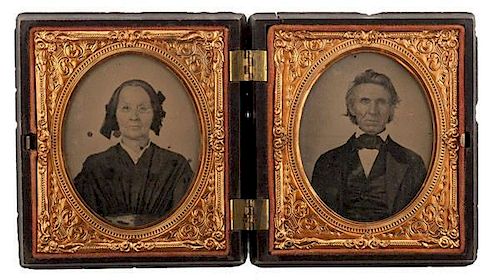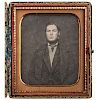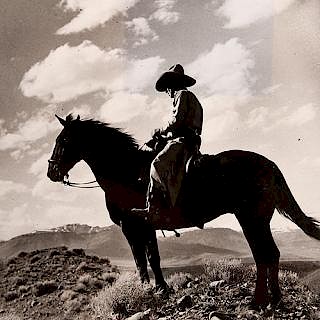Remarkable Daguerreian Archive of a California Gold Miner
About Seller
6270 Este Ave.
Cincinnati , OH 45232
United States
With offices in Cincinnati, Cleveland and Denver, Cowan’s holds over 40 auctions each year, with annual sales exceeding $16M. We reach buyers around the globe, and take pride in our reputation for integrity, customer service and great results. A full-service house, Cowan’s Auctions specializes in Am...Read more
Two ways to bid:
- Leave a max absentee bid and the platform will bid on your behalf up to your maximum bid during the live auction.
- Bid live during the auction and your bids will be submitted real-time to the auctioneer.
Bid Increments
| Price | Bid Increment |
|---|---|
| $0 | $25 |
| $500 | $50 |
| $1,000 | $100 |
| $2,000 | $250 |
| $5,000 | $500 |
| $10,000 | $1,000 |
| $20,000 | $2,500 |
| $50,000 | $5,000 |
| $100,000 | $10,000 |
About Auction
Jun 12, 2015 - Jun 13, 2015
Cowan's Auctions dawnie@cowans.com
- Lot Description
Lot includes 2 quarter plate and 3 sixth plate daguerreotypes, double sixth plate ambrotypes (housed in a geometric union case), and a partially printed receipt for passage on the clipper ship Governor Morton.
This remarkable group documents the passage of young Charles Hayden Gray from a young "down easter" to rough-hewn California goldminer. Born in 1831 to Edward Gray and Susan Getchell (Figure 1), Charles joined the thousands who headed west after the strike at Sutter's Mill, embarking from New York City on the fast clipper Gov. Morton on February 9, 1852 bound for San Francisco. His passage is commemorated by a partially printed 8.5 x 4.25 in. receipt for second class passage printed in red on blue paper from the Empire Line. San Francisco Packet of New York (Figure 2). On the verso is printed the weekly menu of the passengers, a monotonous offering of beef, beans, molasses, coffee, and the occasional pickle and pork.
Gray joined 104 other passengers, arriving in the city by the bay on July 15, 1852 after a 124-day passage which took the Morton around the Horn. The ship's arrival was duly noted in the July 15, 1852 edition of the Daily Alta California, Reference to our shipping memoranda will show the arrival of the ship "Gov. Morton" from New York...having on board one hundred eight passengers. This is the largest number of passengers that has arrived in one ship by the way of Cape Horn in many months. It recalls the early days of emmigration to California... Apparently, the journey was not a happy one, for the Alta also recorded: The passengers...adopting the fashionable method of an "expression" at the "close of a long journey", by a card to the captain and officers of the vessels, present...one of the spiciest "tokens" that we have read for many a day. Such a torrent of complaint and censure could only emanate from a shipload of passengers whose patience as well as their bread, butter and "small stores" had been exhausted by a trip around the horn.
Gray's photographic transformation begins with his sixth plate daguerreotype wearing his Sunday best, and sporting a neat beard, that reveals his cheeks and upper lip (Figure 3). In this image Gray appears to be in his early 20s, and it is easy to speculate that this was taken just prior to his departure for California. After Gray's embarkation in San Francisco, he seems to have outfitted himself for the mines; we believe the quarter plate illustrated in Figure 4 was taken shortly afterwards and shows him in his miner's "get-up." In this fine, vertical image, Gray sports the same beard, but now considerably fuller and lengthened after 124 days aboard the Morton. Gray strikes a confident pose, hand on hip, wearing a striped blouse, a wide, dark kerchief at the neck, his head topped by a wide-brimmed hat. Around his waist is belt with a two-piece buckle favored by miners, and the butt of a holstered revolver -- perhaps a M1849 Colt Pocket Police --is strikingly visible at his side.
The next image (Figure 5) -- a sixth plate housed in a full leather case -- shows Gray some months later. His beard and hair have grown longer, but his face still records a determined optimism. His striped blouse is open wide, and he poses with his hand at his waist -- his miner's belt still visible. While we know nothing of the specifics of Gray's mining experience, the next image, a quarter plate housed in a leather case -- suggests it was not a happy one (Figure 6). In this horizontal pose taken at an unknown, though presumably later date, Gray wears a different blouse, with a chain, highlighted in gilt visible on his breast. His hair is now shorter, and his beard still full, has been trimmed. To his right another figure has been neatly, and purposely removed by a series of vertical wipes. We assume the missing person to be Gray's partner, and the image a remembrance of a relationship gone bad.
We can probably guess that Gray, like most gold-seekers, failed to find his fortune. He remained, in California, however, and married E.C. Sawyer in March of 1855. The 1880 census records him as merchant, selling "General Merchandise" residing in Eden, Alameda County. His death is unrecorded. Lot includes an additional sixth plate daguerreotype of an unidentified young woman produced by North of Cleveland, OH, printed census information, and history of the Gov. Morton. A fine grouping, made all the more remarkable by Gray's retention of his original receipt for passage.Receipt with folds, and minor losses; double ambrotype of Gray's parents both exhibit loose emulsion; Figure 3, plate w/original seals, mop case fine; Figure 4, plate w/original seals, his right cheek with misapplied tinting(?), else EXC, case fine; Figure 3, plate w/original seals, case fine; Figure 5, plate lacking seals, obviously damaged, case fine.Condition
- Shipping Info
-
SHIPPING. At the request of the buyer, Cowan's will authorize the shipment of purchased items. Shipments usually occur within two weeks after payment has been received. Shipment is generally made via UPS Ground service. Unless buyer gives special instructions, the shipping method shall be at the sole discretion of Cowan's Auctions, Inc.. Cowan's is in no way responsible for the acts or omissions of independent handlers, packers or shippers of purchased items or for any loss, damage or delay from the packing or shipping of any property.
-
- Buyer's Premium



 EUR
EUR CAD
CAD AUD
AUD GBP
GBP MXN
MXN HKD
HKD CNY
CNY MYR
MYR SEK
SEK SGD
SGD CHF
CHF THB
THB


















